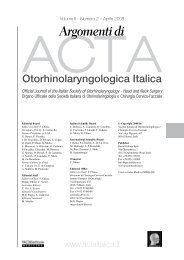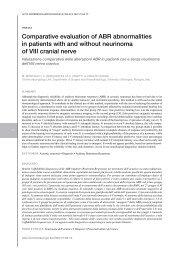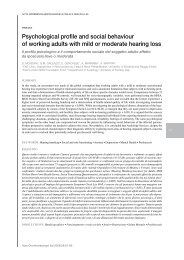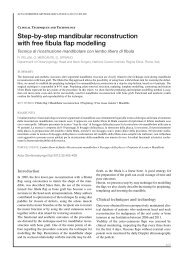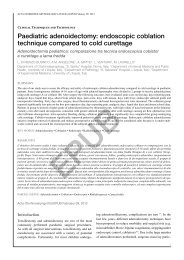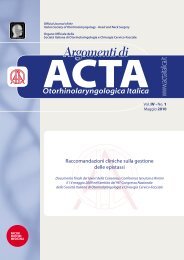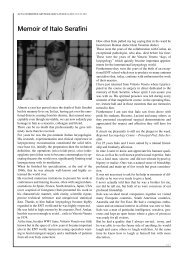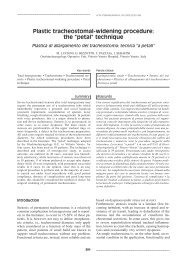Respiratory epithelial adenomatoid hamartoma of the maxillary sinus
Respiratory epithelial adenomatoid hamartoma of the maxillary sinus
Respiratory epithelial adenomatoid hamartoma of the maxillary sinus
Create successful ePaper yourself
Turn your PDF publications into a flip-book with our unique Google optimized e-Paper software.
ACTA OTORHINOLARYNGOL ITAL 26, 225-227, 2006<br />
<strong>Respiratory</strong> <strong>epi<strong>the</strong>lial</strong> <strong>adenomatoid</strong> <strong>hamartoma</strong> <strong>of</strong> <strong>the</strong><br />
<strong>maxillary</strong> <strong>sinus</strong>: case report<br />
Amartoma <strong>adenomatoid</strong>e epiteliale respiratorio del seno mascellare:<br />
caso clinico<br />
R. DI CARLO, R. RINALDI 1 , G. OTTAVIANO, A. PASTORE<br />
E.N.T. Department, 1 Pathology Department, University <strong>of</strong> Ferrara, Ferrara, Italy<br />
Key words<br />
Maxillary <strong>sinus</strong> • Paranasal <strong>sinus</strong> neoplasm • Chronic <strong>sinus</strong>itis<br />
• Surgical treatment • Epi<strong>the</strong>lial <strong>adenomatoid</strong> <strong>hamartoma</strong><br />
Parole chiave<br />
Seno mascellare • Neoplasie dei seni paranasali • Sinusiti<br />
croniche • Terapia chirurgica • Amartoma <strong>adenomatoid</strong>e<br />
epiteliale<br />
Summary<br />
The case is described <strong>of</strong> a male patient with respiratory <strong>epi<strong>the</strong>lial</strong><br />
<strong>adenomatoid</strong> <strong>hamartoma</strong> <strong>of</strong> <strong>the</strong> left <strong>maxillary</strong> <strong>sinus</strong> that initially<br />
presented as a chronic <strong>sinus</strong> inflammation. This benign<br />
lesion is characterized by glandular proliferation originating<br />
from <strong>the</strong> surface <strong>of</strong> <strong>the</strong> respiratory epi<strong>the</strong>lium. Maxillary <strong>sinus</strong><br />
localisation is very rare but is very important to be able to distinguish<br />
<strong>hamartoma</strong>s from schneiderian papillomas <strong>of</strong> <strong>the</strong> inverted<br />
type and adenocarcinomas, potentially requiring aggressive<br />
surgical treatment. Moreover, misinterpretation <strong>of</strong> <strong>the</strong> respiratory<br />
<strong>epi<strong>the</strong>lial</strong> <strong>adenomatoid</strong> <strong>hamartoma</strong> as chronic <strong>sinus</strong><br />
inflammation may result in inadequate treatment. The clinical<br />
and pathological features <strong>of</strong> this lesion are discussed.<br />
Riassunto<br />
Si descrive un caso di amartoma <strong>adenomatoid</strong>e epiteliale<br />
respiratorio del seno mascellare esordito come una <strong>sinus</strong>ite<br />
cronica. L’amartoma <strong>adenomatoid</strong>e epiteliale respiratorio<br />
è una rara lesione benigna caratterizzata dalla proliferazione<br />
ghiandolare dell’epitelio respiratorio. La localizzazione<br />
al seno mascellare è del tutto eccezionale, ma è<br />
importante riconoscerla e differenziarla dai papillomi<br />
invertiti e dagli adenocarcinomi che necessitano di trattamenti<br />
chirurgici più aggressivi e dalle <strong>sinus</strong>iti ipertr<strong>of</strong>iche<br />
che necessitano, per contro, di un trattamento più conservativo.<br />
Vengono discussi gli aspetti clinici e anatomopatologici<br />
di questa patologia.<br />
The term “<strong>hamartoma</strong>” was first used in 1904 as tumour-like,<br />
but primary, non-neoplastic malformations<br />
or inborn errors <strong>of</strong> tissue development 1 .<br />
Hamartomas can occur in any part <strong>of</strong> <strong>the</strong> body, for<br />
example, <strong>the</strong> surface epi<strong>the</strong>lium, seromucous glands,<br />
fibrous stroma, and vessels 2 .<br />
They are common in <strong>the</strong> lung, kidney, liver, spleen,<br />
and intestine but are extremely rare in <strong>the</strong> upper<br />
aerodigestive tract 3 .<br />
In 1995, Wenig and Heffner found a subgroup <strong>of</strong><br />
<strong>hamartoma</strong> more <strong>of</strong>ten involving <strong>the</strong> nasal cavity or<br />
nasopharynx and named it respiratory <strong>epi<strong>the</strong>lial</strong> <strong>adenomatoid</strong><br />
<strong>hamartoma</strong> (REAH) 4 .<br />
This rare benign lesion originates in <strong>the</strong> schneiderian<br />
epi<strong>the</strong>lium, with glandular elements arising from this<br />
epi<strong>the</strong>lium but not from <strong>the</strong> seromucous glands.<br />
The case is described <strong>of</strong> REAH <strong>of</strong> <strong>the</strong> <strong>maxillary</strong> <strong>sinus</strong><br />
and a review is made <strong>of</strong> reports concerning <strong>adenomatoid</strong><br />
<strong>hamartoma</strong>s in <strong>the</strong> <strong>sinus</strong>es and nasal cavity.<br />
Case report<br />
A 62-year-old male presented with a > 3-year history <strong>of</strong><br />
cacosmia with posterior rhinorrhea. Symptoms were not<br />
relieved by antibiotic treatment. The patient also had a<br />
history <strong>of</strong> neurosurgical treatment <strong>of</strong> <strong>the</strong> left trigeminal<br />
neuralgia with middle facial anaes<strong>the</strong>sia.<br />
Chest X-ray, electrocardiogram (EKG) and routine<br />
blood tests were all within normal limits. Physical<br />
examination showed polyps occupying <strong>the</strong> left middle<br />
meatus. Computed tomography (CT) revealed<br />
complete opacification <strong>of</strong> <strong>the</strong> left <strong>maxillary</strong> <strong>sinus</strong><br />
with bone thickening (Fig. 1). The patient underwent<br />
functional endoscopic <strong>sinus</strong> surgery under general<br />
anaes<strong>the</strong>sia to remove polyps and <strong>the</strong> lower portion<br />
<strong>of</strong> <strong>the</strong> uncinate process, followed by <strong>the</strong> creation <strong>of</strong> a<br />
middle meatus antrostomy to restore <strong>sinus</strong> ventilation<br />
and normal function.<br />
The <strong>maxillary</strong> <strong>sinus</strong> was occupied by a purulent fluid<br />
and <strong>the</strong> mucosa was hyperaemic, hypertrophic and<br />
very bloody. On <strong>the</strong> basis <strong>of</strong> intra-operative findings<br />
biopsy was required and a histological diagnosis <strong>of</strong><br />
REAH was made.<br />
Given <strong>the</strong> diagnosis <strong>of</strong> <strong>the</strong> REAH <strong>of</strong> <strong>the</strong> <strong>maxillary</strong> <strong>sinus</strong>,<br />
<strong>the</strong> tumour was resected using <strong>the</strong> Caldwell-Luc<br />
procedure. The <strong>maxillary</strong> <strong>sinus</strong> was covered with a circumscribed<br />
and polypoid lesion with a smooth surface,<br />
<strong>of</strong> rubbery consistency and a red-brown appearance (Fig.<br />
2). Histological examination revealed that <strong>the</strong> lesion was<br />
composed <strong>of</strong> well-formed, branching glands <strong>of</strong> various<br />
225
R. DI CARLO ET AL.<br />
Fig. 1. Axial view <strong>of</strong> CT scan: complete opacification <strong>of</strong><br />
left <strong>maxillary</strong> <strong>sinus</strong>.<br />
Fig. 4. Stroma contains mixed chronic inflammatory cell<br />
infiltrate. NB prominent thickened stromal hyalinization<br />
enveloping glands and blood vessels (H&E, 2x).<br />
Fig. 2. Gross findings: lesion was circumscribed and<br />
polypoid, with smooth surface, rubbery consistency,<br />
red-brown appearance, measuring up to 4 cm in maximum<br />
dimension. A short stalk was also present.<br />
Fig. 3. <strong>Respiratory</strong> <strong>epi<strong>the</strong>lial</strong> <strong>adenomatoid</strong> <strong>hamartoma</strong><br />
(REAH): glandular proliferation is found in direct continuity<br />
with surface epi<strong>the</strong>lium with invagination<br />
downward into submucosa (H&E, 2x).<br />
sizes covered with pseudo-stratified ciliated respiratory<br />
<strong>epi<strong>the</strong>lial</strong> cells separated by stromal tissue. The surface<br />
<strong>of</strong> <strong>the</strong> lesion was lined with ciliated respiratory epi<strong>the</strong>lium<br />
in a direct continuity with some <strong>of</strong> <strong>the</strong> glands,<br />
creating a tubular appearance with elongated invaginations<br />
into <strong>the</strong> underlying loose myxoid lamina propria<br />
(Fig. 3). Cystic glands containing eosinophilic material<br />
or distended with mucus were found. A characteristic<br />
finding was stromal hyalinization with a thick<br />
eosinophilic basement membrane covering <strong>the</strong> glands.<br />
O<strong>the</strong>r abnormal features included stromal oedema, n-<br />
odular stromal hyperplasia, seromucinous glands proliferation,<br />
increased vascularity and a mixed acute and<br />
chronic inflammatory infiltrate (Fig. 4).<br />
The patient is well and without recurrence <strong>of</strong> symptoms<br />
at 10-month follow-up.<br />
Discussion<br />
Hamartomas may be viewed as malformations composed<br />
<strong>of</strong> an excessive proliferation <strong>of</strong> one or more<br />
cellular components specific to a given tissue. They<br />
are not clearly neoplastic and are definitely not inflammatory.<br />
In contrast to neoplasms, <strong>hamartoma</strong>s<br />
do not have <strong>the</strong> capability <strong>of</strong> a continuous unimpeded<br />
growth 4 . They are, <strong>the</strong>refore, self-limiting. In<br />
general, <strong>hamartoma</strong>s have no malignant potential and<br />
no tendency to regress spontaneously.<br />
Over 80% <strong>of</strong> <strong>the</strong> patients with REAH are males, age<br />
ranging from <strong>the</strong> third to <strong>the</strong> ninth decade <strong>of</strong> life,<br />
with a median age in <strong>the</strong> 6 th decade 2-13 .<br />
In our patient, <strong>the</strong>re was no relationship to any aspecific<br />
aetiologic agent and no correlation with tobacco<br />
use or alcohol abuse could be established.<br />
Presenting symptoms are vague and non-specific, <strong>of</strong>ten<br />
including nasal obstruction, nasal stuffiness, epistaxis,<br />
rhinorrhea and allergy-like symptoms.<br />
CT and magnetic resonance imaging (MRI) show no<br />
characteristic signs as <strong>the</strong>y vary according to <strong>the</strong><br />
main element <strong>of</strong> <strong>the</strong> <strong>hamartoma</strong> 2 5-7 .<br />
226
ADENOMATOID HAMARTOMA OF THE MAXILLARY SINUS<br />
Although <strong>the</strong> mechanisms inducing a <strong>hamartoma</strong> are<br />
still unknown, it has been speculated that <strong>the</strong>y arise<br />
as a result <strong>of</strong> an underlying inflammatory process 4 .<br />
To our knowledge, 39 cases <strong>of</strong> REAH have been reported<br />
in <strong>the</strong> literature 2 4-13 . Of <strong>the</strong>se cases, 25 (64%)<br />
were identified in <strong>the</strong> nasal cavity 2 4 5 7 10 <strong>the</strong> most<br />
common site being <strong>the</strong> nasal septum, particularly <strong>the</strong><br />
posterior aspect 4 . In <strong>the</strong> nasal cavity, <strong>the</strong> lesions<br />
were not limited to <strong>the</strong> septum, but were seen to arise<br />
along <strong>the</strong> lateral wall, middle meatus, or inferior<br />
turbinate. In addition to <strong>the</strong> nasal cavity, <strong>the</strong> o<strong>the</strong>r<br />
cases more <strong>of</strong>ten involved <strong>the</strong> nasopharynx (n = 8) 4<br />
5 9 13<br />
, <strong>the</strong> ethmoid <strong>sinus</strong> (n = 2) 4 11 , both <strong>the</strong> ethmoid<br />
<strong>sinus</strong> and frontal <strong>sinus</strong> (n = 1) 4 , both <strong>the</strong> <strong>maxillary</strong><br />
<strong>sinus</strong> and ethmoid <strong>sinus</strong> (n = 1) 12 .<br />
The involvement <strong>of</strong> <strong>the</strong> <strong>maxillary</strong> <strong>sinus</strong> alone is quite<br />
rare with only two o<strong>the</strong>r cases having been reported.<br />
In one <strong>of</strong> <strong>the</strong>se, <strong>the</strong> lesion was discovered during <strong>the</strong><br />
course <strong>of</strong> a dental X-ray, as a peri-apical radiolucency<br />
mimicking a peri-apical granuloma and apical periodontal<br />
cyst with no evidence <strong>of</strong> <strong>the</strong> typical sinonasal<br />
symptoms being apparent 8 . In <strong>the</strong> o<strong>the</strong>r case,<br />
only aspecific symptoms were present, like unilateral<br />
nasal obstruction, rhinorrhea and headache 6 .<br />
If <strong>the</strong> <strong>adenomatoid</strong> proliferation is in <strong>the</strong> <strong>maxillary</strong><br />
<strong>sinus</strong>, <strong>the</strong> REAH could most likely be confused with<br />
an inflammatory disorder and <strong>the</strong>re should be no difference<br />
in <strong>the</strong> treatment between <strong>the</strong>se two lesions.<br />
The treatment for <strong>hamartoma</strong> is complete local<br />
excision. There are no reports <strong>of</strong> recurrent, persistent,<br />
or progressive disease, in <strong>the</strong> literature 6 .<br />
The differential diagnosis <strong>of</strong> REAH in para-nasal <strong>sinus</strong><br />
includes inverted papilloma, and adenocarcinoma.<br />
The inverted papilloma derives from <strong>the</strong> schneiderian<br />
membrane and is composed <strong>of</strong> papillary<br />
fronds with a delicate fibrovascular core covered by<br />
multiple layers <strong>of</strong> <strong>epi<strong>the</strong>lial</strong> cells, most <strong>of</strong>ten <strong>of</strong> squamous<br />
or transitional cells, in contrast to <strong>the</strong> REAH,<br />
which shows <strong>adenomatoid</strong> structures lined by a single<br />
layer <strong>of</strong> ciliated columnar epi<strong>the</strong>lium. Sino-nasal<br />
low grade adenocarcinoma may produce an architectural<br />
pattern mimicking that seen in REAH. However,<br />
adenocarcinoma can be distinguished from REAH<br />
by <strong>the</strong> presence <strong>of</strong> numerous uniform small glands or<br />
acini arranged in a back-to-back pattern, cellular<br />
pleomorphism, atypical mitoses, keratin pearls, loss<br />
<strong>of</strong> basement membranes and stromal invasion associated<br />
with an inflammatory-desmoplastic response 14 .<br />
The prevalence <strong>of</strong> occult neoplasia in routine endoscopic<br />
<strong>sinus</strong> surgery is very low 15 but, in our opinion<br />
specimens should be sent for histopathologic examination<br />
when unilateral nasal polyposis, with unilateral<br />
<strong>sinus</strong> opacification, is present toge<strong>the</strong>r with intraoperative<br />
findings.<br />
Head and Neck surgeons should be aware <strong>of</strong> this<br />
pathological entity as a differential diagnosis for inverted<br />
papilloma and adenocarcinoma, in order to<br />
avoid unnecessary aggressive surgery. On <strong>the</strong> o<strong>the</strong>r<br />
hand, misinterpretation <strong>of</strong> REAH as a chronic <strong>sinus</strong><br />
inflammation may result in inadequate treatment.<br />
References<br />
1<br />
Albrecht E. Uber Hamartome. Verh Dtsch Ges Pathol<br />
1904;7:153-7.<br />
2<br />
Endo R, Matsuda H, Takahashi M, Hara M, Inaba H, Tsukuda<br />
M. <strong>Respiratory</strong> <strong>epi<strong>the</strong>lial</strong> <strong>adenomatoid</strong> <strong>hamartoma</strong> in <strong>the</strong> nasal<br />
cavity. Acta Otolaryngol 2002;122:398-400.<br />
3<br />
Kaneko C, Inokuchi A, Kimitsuki T, Kumamoto Y, Shinokuma<br />
A, Natori Y, et al. Huge <strong>hamartoma</strong> with inverted papilloma in<br />
<strong>the</strong> nasal cavity. Eur Arch Otorhinolaryngol 1999;256:S33-7.<br />
4<br />
Wenig BM, Heffner DK. <strong>Respiratory</strong> <strong>epi<strong>the</strong>lial</strong> <strong>adenomatoid</strong><br />
<strong>hamartoma</strong>s <strong>of</strong> <strong>the</strong> sinonasal tract and nasopharynx: A clinicopathologic<br />
study <strong>of</strong> 31 cases. Ann Otol Rhinol Laryngol<br />
1995;104:639-45.<br />
5<br />
Graeme-Cook F, Pilch BZ. Hamartomas <strong>of</strong> <strong>the</strong> nose and nasopharynx.<br />
Head Neck 1992;14:321-7.<br />
6<br />
Himi Y, Yoshizaki T, Sato K, Furukawa M. <strong>Respiratory</strong> <strong>epi<strong>the</strong>lial</strong><br />
<strong>adenomatoid</strong> <strong>hamartoma</strong> <strong>of</strong> <strong>the</strong> <strong>maxillary</strong> <strong>sinus</strong>. J Laryngol<br />
Otol 2002;116:317-8.<br />
7<br />
Delbrouck C, Aguilar SF, Choufan G, Hassid S. <strong>Respiratory</strong> <strong>epi<strong>the</strong>lial</strong><br />
<strong>adenomatoid</strong> <strong>hamartoma</strong> associated with nasal polyposis.<br />
Am J Otolaryngol 2004;25:282-4.<br />
8<br />
Kessler P, Unterman B. <strong>Respiratory</strong> <strong>epi<strong>the</strong>lial</strong> <strong>adenomatoid</strong><br />
<strong>hamartoma</strong> <strong>of</strong> <strong>the</strong> <strong>maxillary</strong> <strong>sinus</strong> presenting as a periapical radiolucency:<br />
Acase report and review <strong>of</strong> <strong>the</strong> literature. Oral Surg<br />
Oral Med Oral Pathol Oral Radiol Endod 2004;97:607-12.<br />
9<br />
Gonzales RP, Siguenza GM, Alonso JA, Orcajo NA, Rubio CC.<br />
Hamartoma de la nas<strong>of</strong>aringe. Revision y aportacion de un nuevo<br />
caso. ORL-DIPS 2003;30:156-9.<br />
10<br />
Braun H, Beham A, Stammberger H. <strong>Respiratory</strong> epi<strong>the</strong>loid <strong>adenomatoid</strong><br />
<strong>hamartoma</strong> <strong>of</strong> <strong>the</strong> nasal cavity – case report and review<br />
<strong>of</strong> <strong>the</strong> literature. Laryngorhinootologie 2003;82:416-20.<br />
11<br />
Malinvaud D, Halimi P, Cote JF, Vilde F, Bonfils P. Adenomatoid<br />
<strong>hamartoma</strong> <strong>of</strong> <strong>the</strong> ethmoid <strong>sinus</strong>: one case report. Rev Laryngol<br />
Otol Rhinol 2004;125:45-8.<br />
12<br />
Starska K, Lucomski M, Ratynska M. Rare case <strong>of</strong> <strong>the</strong> respiratory<br />
<strong>epi<strong>the</strong>lial</strong> <strong>adenomatoid</strong> <strong>hamartoma</strong> <strong>of</strong> <strong>the</strong> nasal cavity,<br />
<strong>maxillary</strong> <strong>sinus</strong> et ethmoid <strong>sinus</strong>es: a clinicopathologic study.<br />
Otolaryngol Pol 2005;59:421-4.<br />
13<br />
Metselaar RM, Stel HV, van der Bann S. <strong>Respiratory</strong> <strong>epi<strong>the</strong>lial</strong><br />
<strong>adenomatoid</strong> <strong>hamartoma</strong> in <strong>the</strong> nasopharynx. J Laryngol Otol<br />
2005;119:476-8.<br />
14<br />
Barnes L. Scheiderian papillomas and non salivary glandular<br />
neoplasms <strong>of</strong> <strong>the</strong> head and neck. Modern Pathol 2002;15:279-97.<br />
15<br />
Romashko AA, Stankiewicz JA. Routine histopathology in uncomplicated<br />
<strong>sinus</strong> surgery: is it necessary Otolaryngol Head<br />
Neck Surg 2005;132:407-12.<br />
n Received: February 22, 2006<br />
Accepted: March 20, 2006<br />
n Address for correspondence: Dr. G. Ottaviano,<br />
Dipartimento di Otorinolaringoiatria, Ospedale “S. Anna”,<br />
c.so Giovecca 203, 44100 Ferrara, Italy.<br />
Fax +39 0532 236317. E-mail: pippifonica@yahoo.it<br />
227



